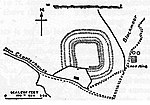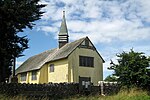Blagdon
Civil parishes in SomersetMendip HillsPages with Gutenberg book template using bulletUse British English from August 2012Villages in North Somerset

Blagdon is a village and civil parish in the ceremonial county of Somerset, within the unitary authority of North Somerset, in England. It is located in the Mendip Hills, a recognised Area of Outstanding Natural Beauty. According to the 2011 census it has a population of 1,116. The village is about 12 miles (19 km) east of Weston-super-Mare on the A368 between Churchill and Compton Martin.
Excerpt from the Wikipedia article Blagdon (License: CC BY-SA 3.0, Authors, Images).Blagdon
Bath Road,
Geographical coordinates (GPS) Address Nearby Places Show on map
Geographical coordinates (GPS)
| Latitude | Longitude |
|---|---|
| N 51.327 ° | E -2.717 ° |
Address
Bath Road
Bath Road
BS40 7RR
England, United Kingdom
Open on Google Maps










